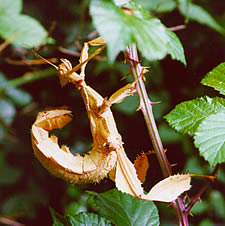Stick insects and Leaf insects (Order: Phasmatodea)

The Giant Spiny Stick insect (Extatosoma tiaratum) is one of the commonly kept pet species.
Photograph by Stephan M. Höhne, used under GFDL.
Introduction
The Stick insects (sometimes called 'walking sticks') and Leaf insects are some of the most well known of all insects. They are commonly kept as pets and are famous for their superb camouflage (crypsis). Many species closely resemble leaves, grasses or twigs. Some leaf insects even have patches on them that make them look like damaged leaves. Stick insects and leaf insects are herbivores - that is they eat plants. Collectively, stick insects and leaf insects are often referred to as Phasmids.
Phasmids first appeared in the fossil record over 40 million years ago and they are related to cockroaches, mantids and, more distantly, the grasshoppers and crickets.
There are over 2,500 species of Phasmid and three have been accidentally introduced to Great Britain.
Main characteristics of Stick insects and Leaf insects
Phasmids are medium to very large (30-300mm) insects. Stick insects are usually very thin and elongated. In contrast Leaf insects are often very flat and wide, thus more closely resembling leaves rather than sticks. Many species are wingless but, when wings are present, the fore wings are shortened and hardened. The hind wings are membranous. The legs are often very thin and can be held almost flat against the body of the insect.
Some species have brightly coloured hind wings which can be 'flashed' to scare away predators. Other species, such as the American Walking Stick (Anisomorpha bupestroides) and to a lesser extent the Pink Winged Stick insect (Sipyloidea sipylus), have a defensive chemical spray which can cause temporary blindness and considerable pain to humans.
Life-history
In some species males are rarely (or never) seen. The females of these species reproduce parthenogenically. That is, the females lay unfertilised eggs which hatch into females which also lay unfertilised eggs. However, in many species both males and females are present.
Most phasmids lay eggs singly and commonly the eggs resemble seeds. Some species release these and let them fall to the ground where they become hidden amongst the leaf litter. Other species will descend to ground level and, using a blade-like ovipositor, lay single eggs underground. It can take a very long time for the eggs to hatch. In some species this can even be as long as six months to a year.
Phasmids undergo incomplete metamorphosis and the nymphs look like small versions of the adults. The wings, if present, only appear at the final moult.
The average lifespan for stick and leaf insects is twelve months but, in captivity, they can live longer. They make excellent pets and there are caresheets for Stick insects and Leaf insects available on this site.
Classification
At one time the phasmids were considered to be part of the Order: Orthoptera (Grasshoppers and Crickets) but have since been classified as a separate Order called Phasmatodea although some people use Phasmida or Cheleutoptera instead.
How to find them
Three species can be found in Great Britain but these are thought to have been accidentally introduced on plants. The three species are the Smooth Stick insect (Clitarchus hookeri), the Prickly Stick insect (Acanthoxyla geisovii) and the Unarmed Stick insect (Acanthoxyla inermis). The three species are confined to small colonies in the south west England and the Scilly Isles.
Essential reading from the Amateur Entomologists' Society
- Rearing and Studying Stick and Leaf-insects (Vol. 22)
- The Amazing World of Stick and Leaf insects (Vol. 26)
A to Z of insects
- Alderflies
- Ants
- Antlions
- Archaeognatha
- Barklice
- Bees
- Beetles
- Biting lice
- Booklice
- Butterflies
- Bugs
- Caddisflies
- Cockroaches
- Crickets
- Damselflies
- Dobsonflies
- Dragonflies
- Earwigs
- Fleas
- Flies
- Grasshoppers
- Lacewings
- Leaf insects
- Lice
- Mantids
- Mayflies
- Moths
- Praying Mantids
- Scorpionflies
- Snakeflies
- Stick insects
- Stoneflies
- Strepsipterans
- Sucking lice
- Termites
- Three-pronged bristletails
- Thrips
- True Bugs
- Wasps
- Web-spinners
- Zorapterans
- Non-insect hexapods
- Proturans
- Springtails
- Two-pronged bristletails
Back to Insect Orders.
![Amateur Entomologists' Society home page [Logo]](/images/aes-logo-wplant.gif)